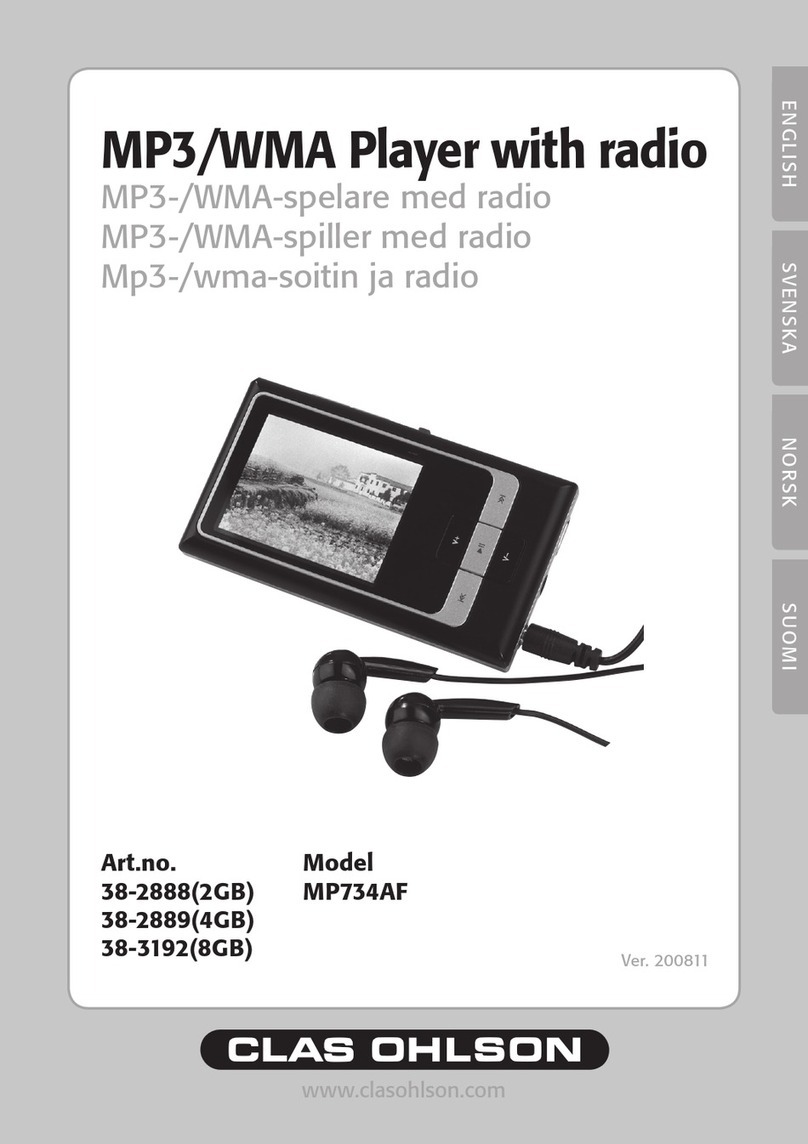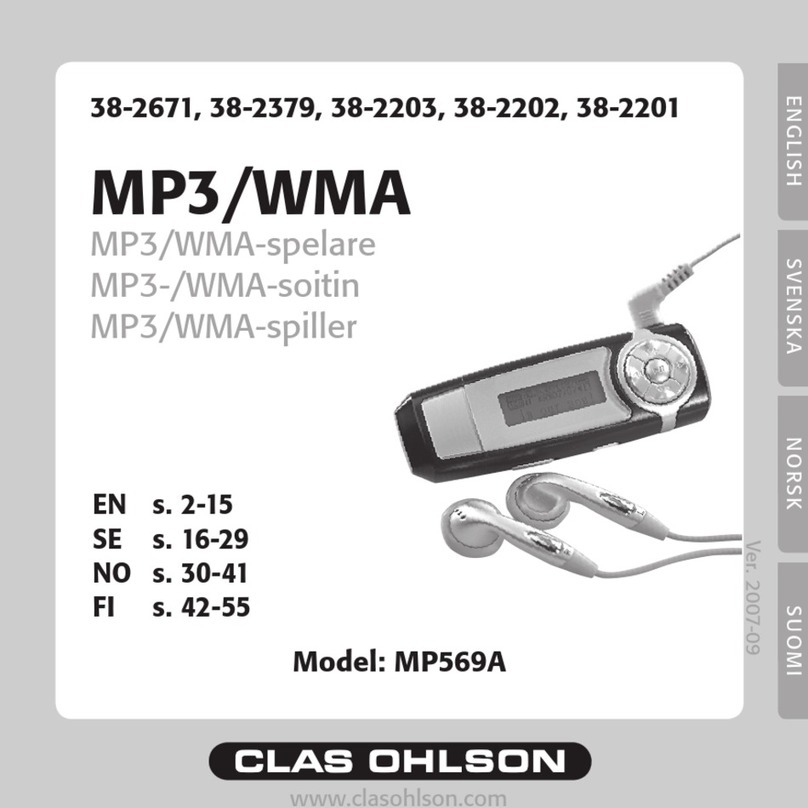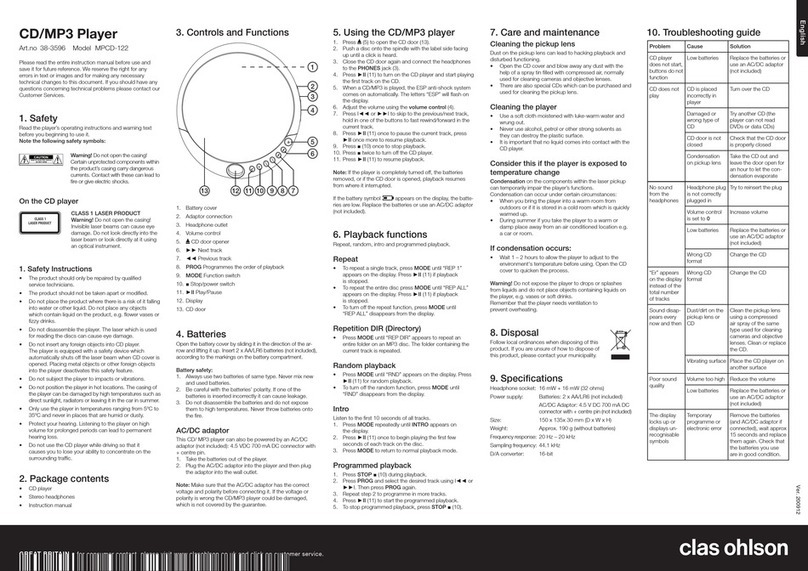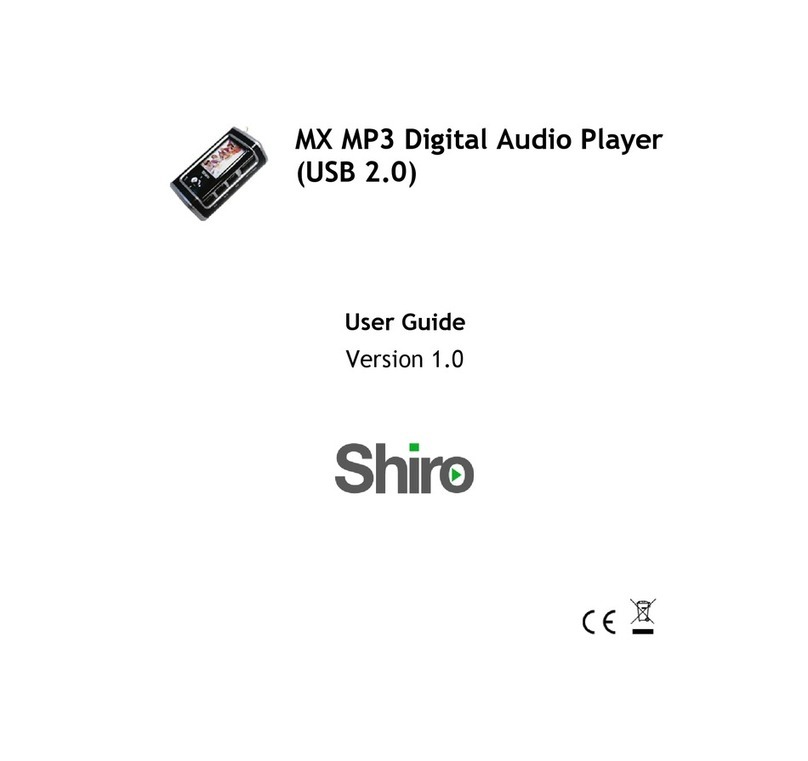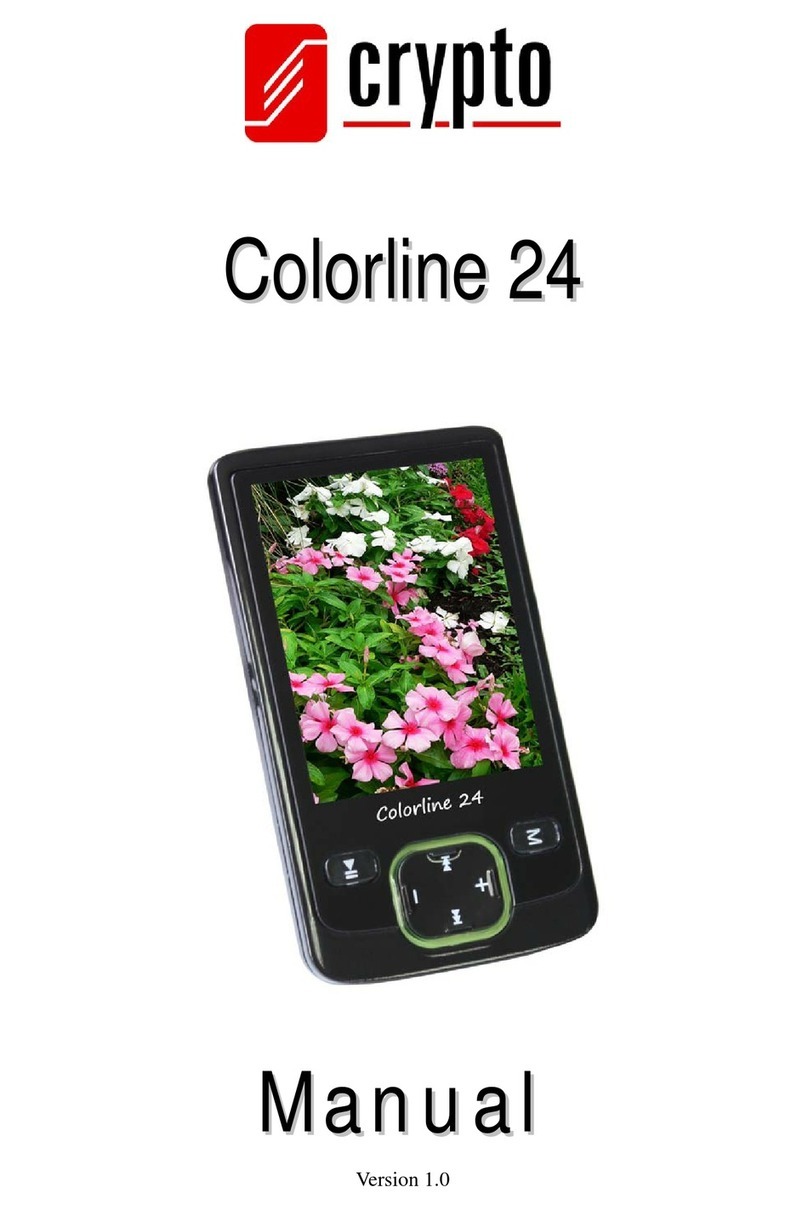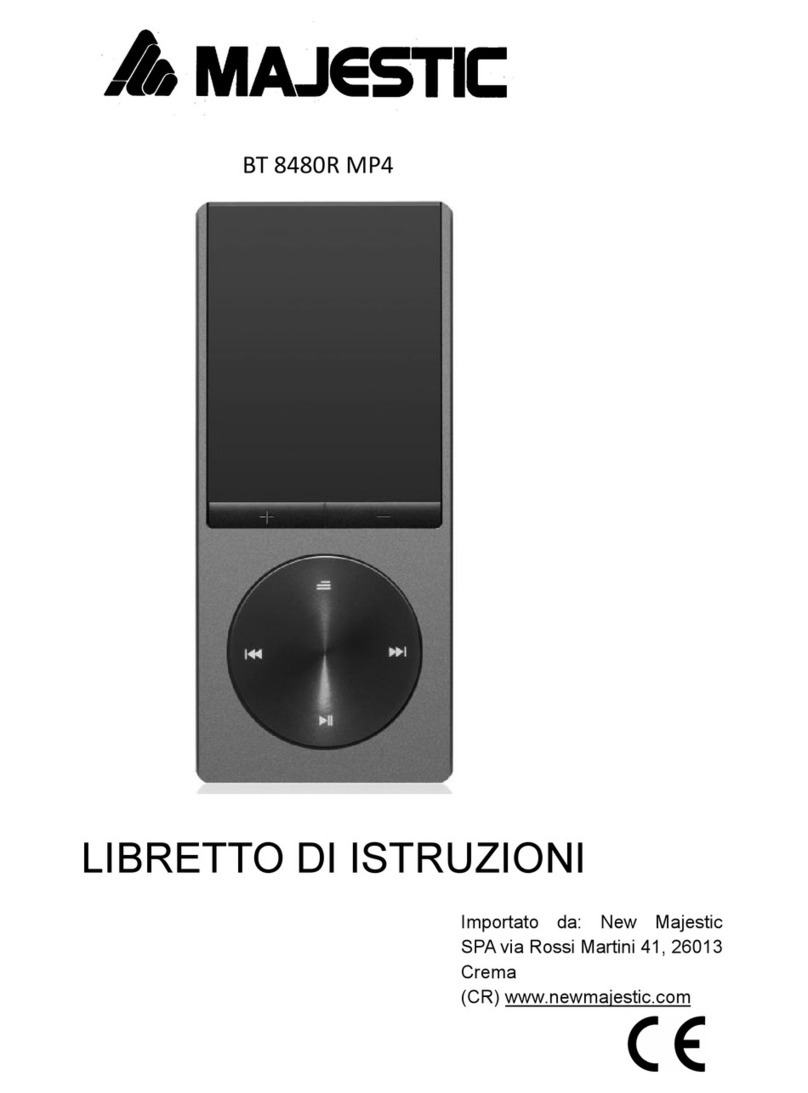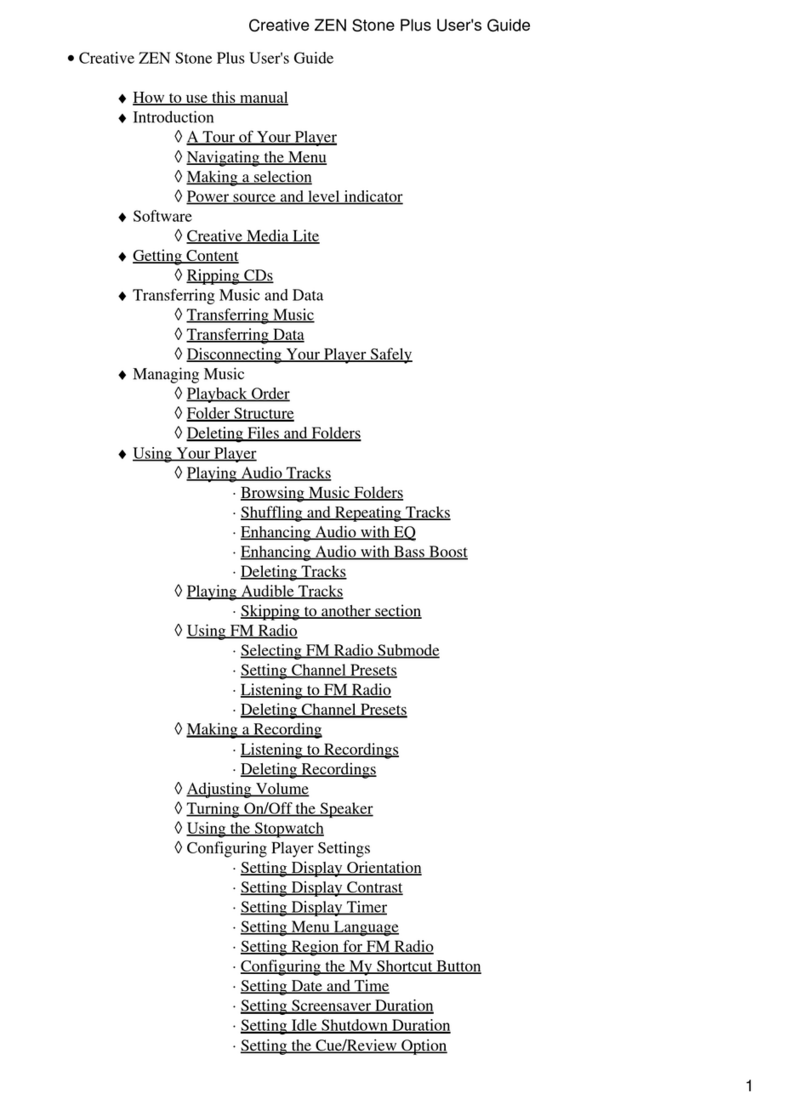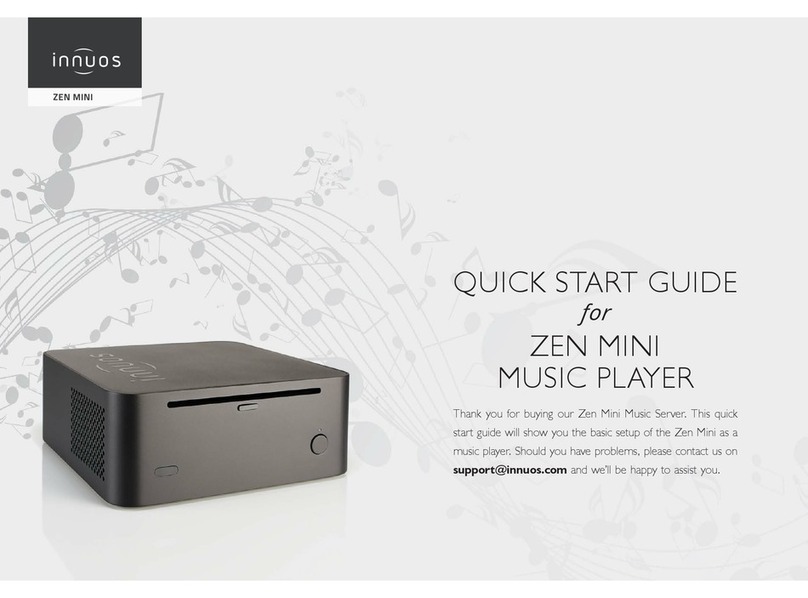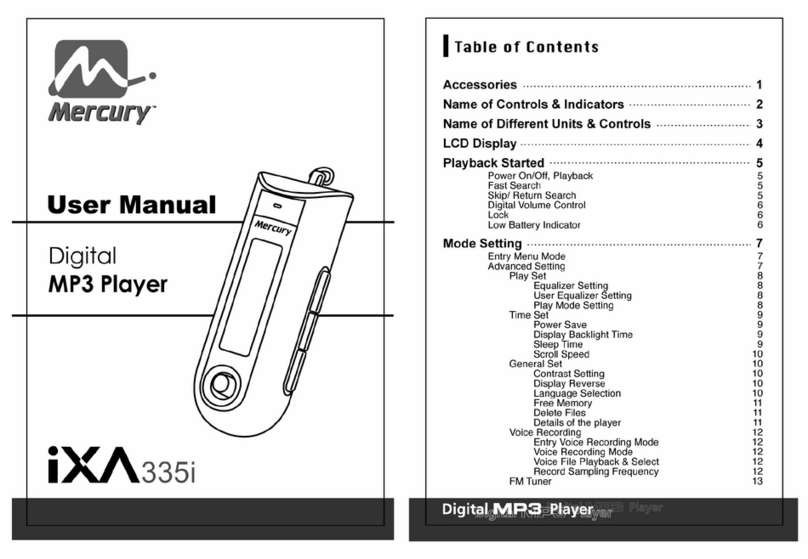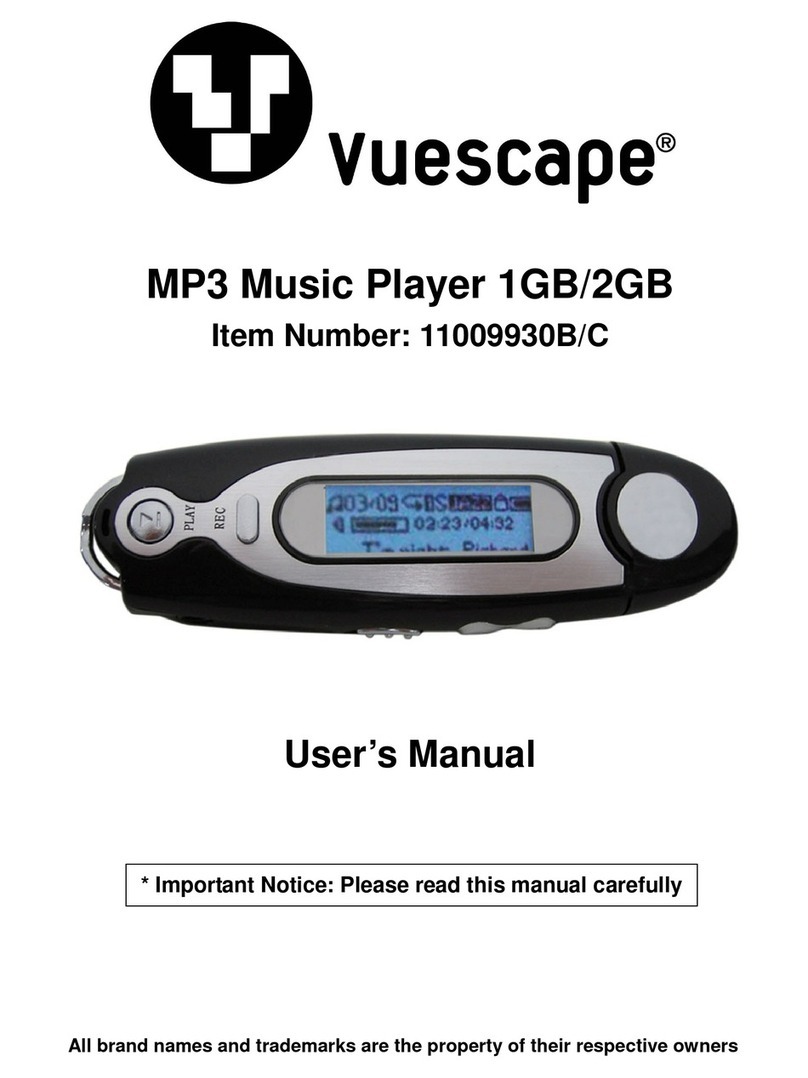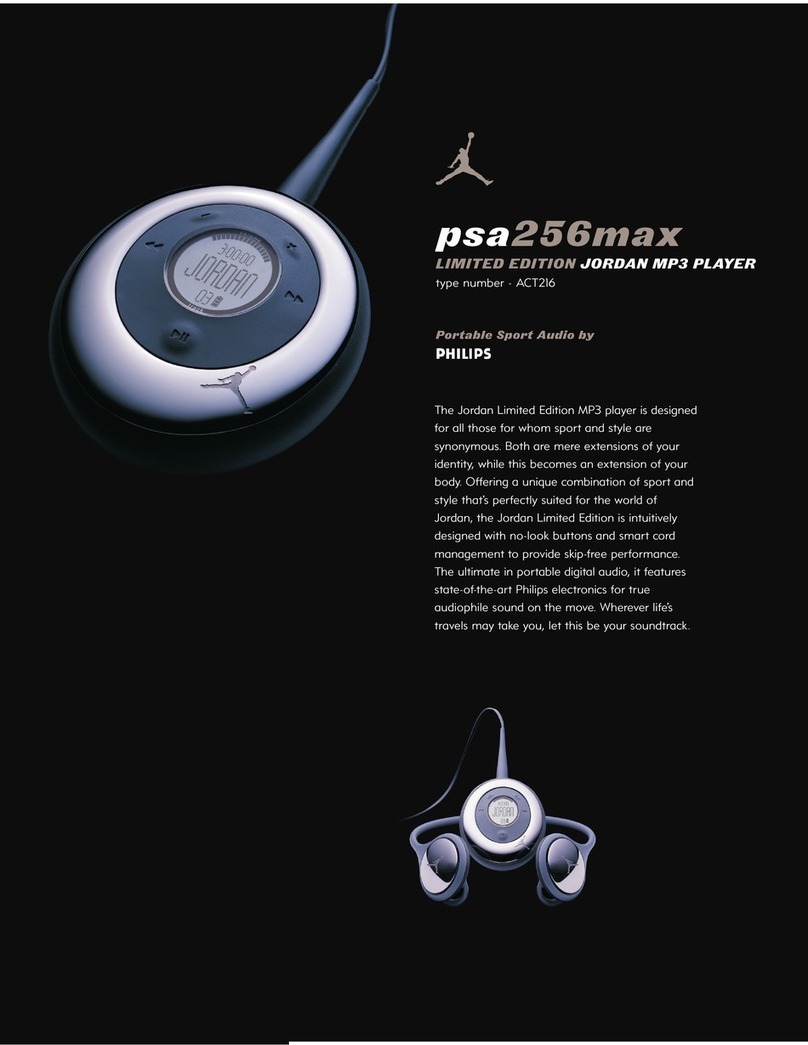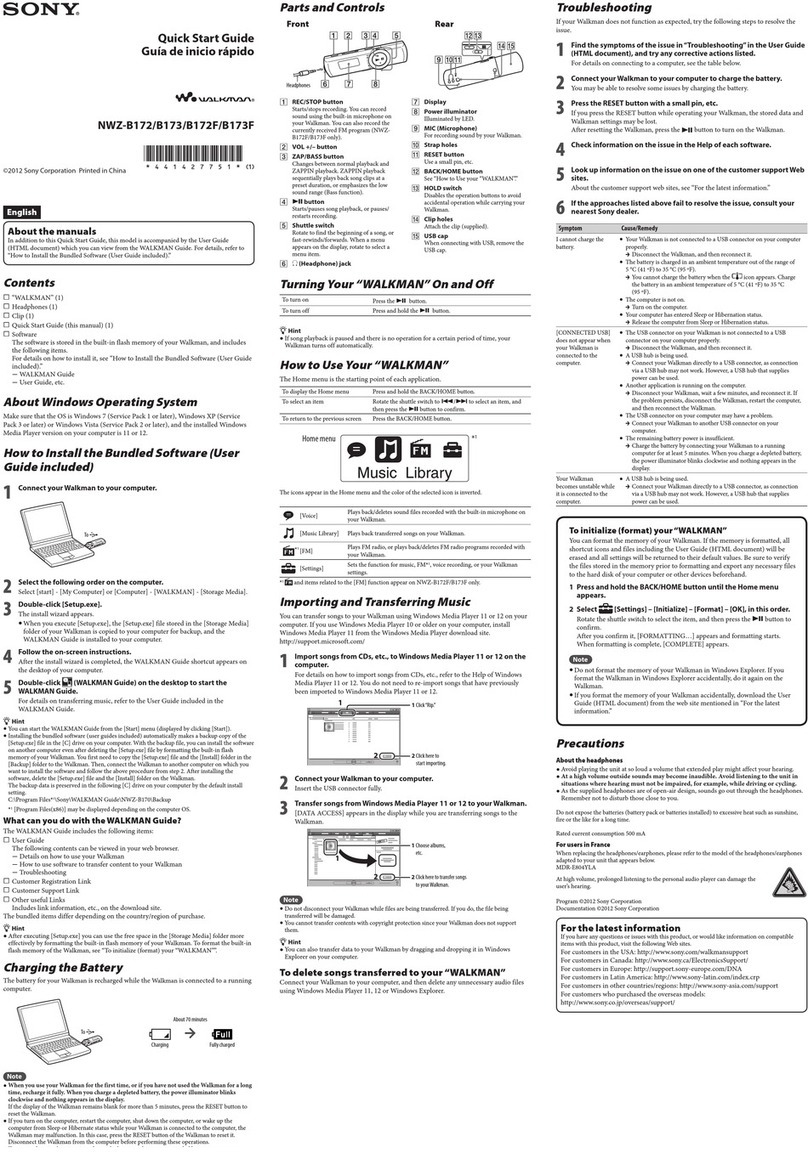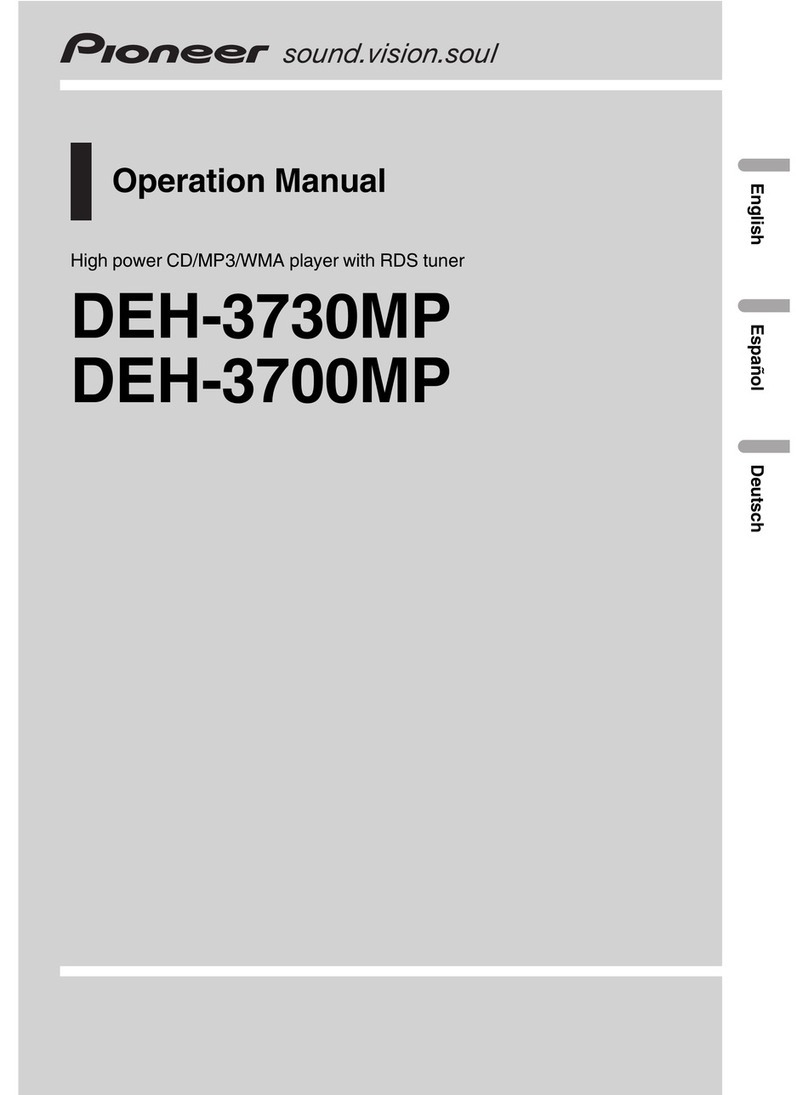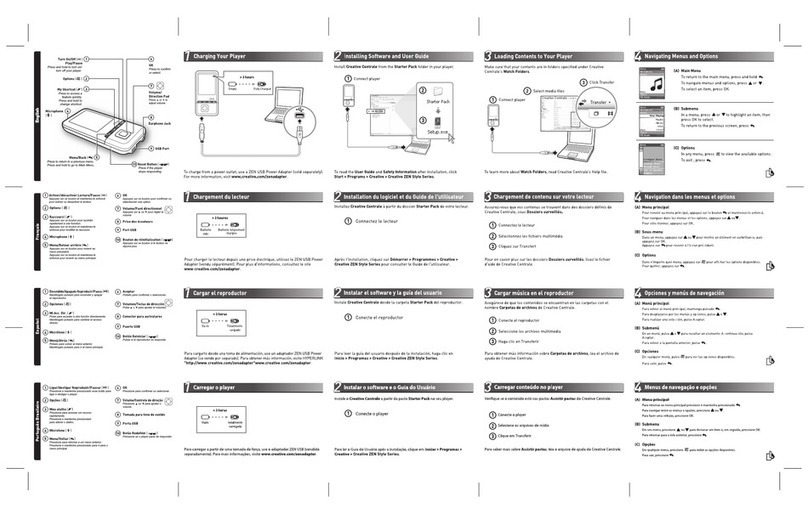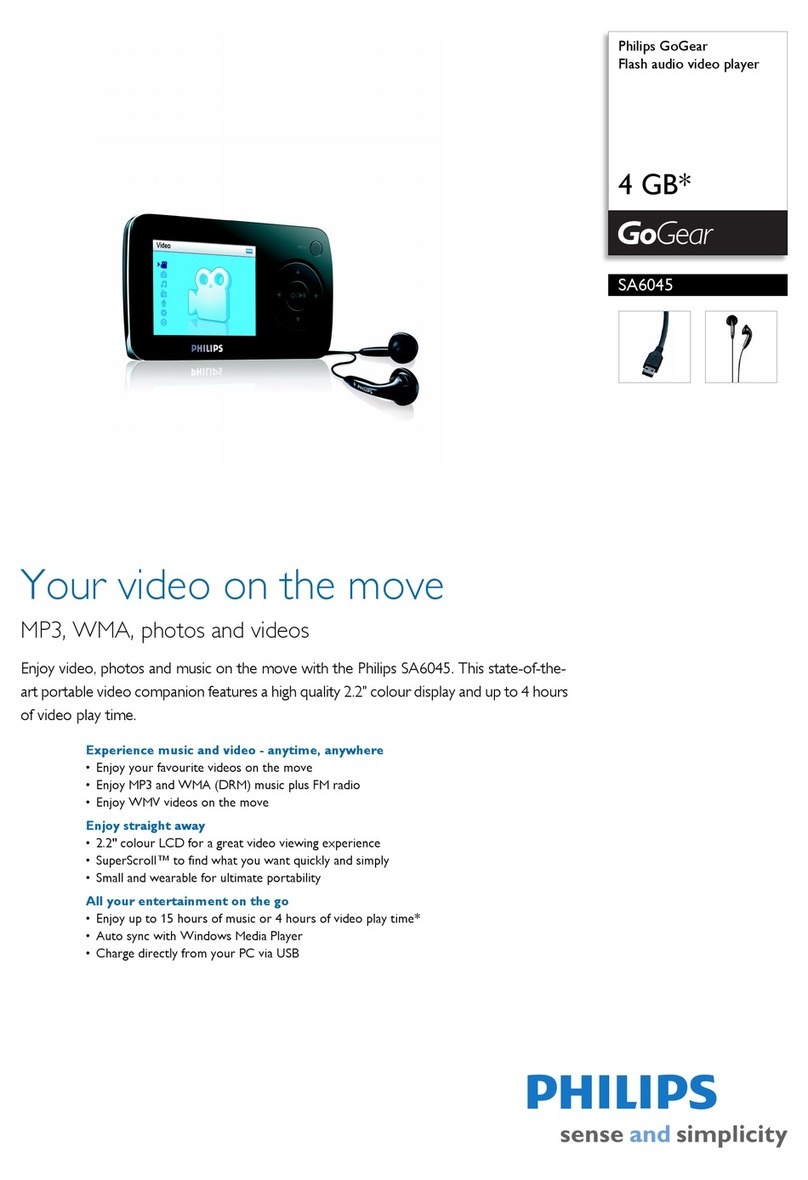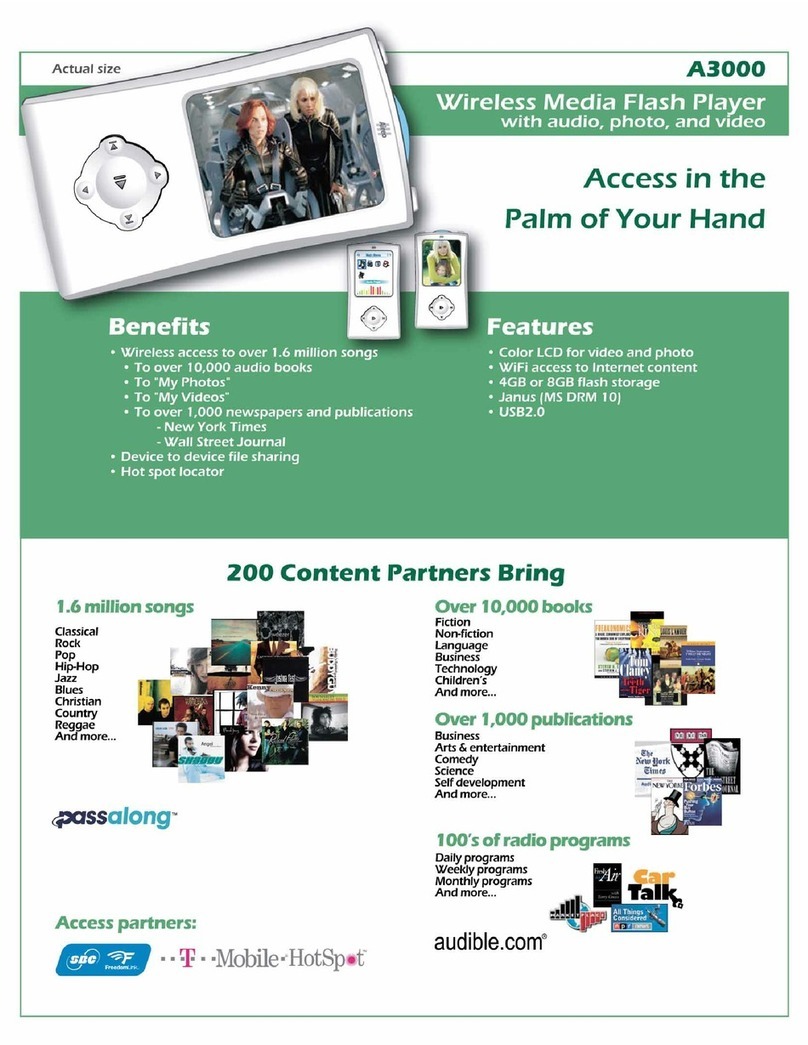Clas Ohlson CDM32 User manual

NORSKENGLISH
CD/MP3-Player
CD/MP3-spiller
Model CDM32-60F3
38-1635
Ver. 200801

2

3
ENGLISH
CD/MP3-Player
Art. no. 38-1635, model CDM32
Caution!
Do not open the casing! Invisible laser
irradiation can cause damage to the eyes.
Do not point the laser beam toward you eyes,
and do not look directly in to the instrument.
Laser product of Class 1

4
ENGLISH
1. Safety Directions
• Do not disassemble the player, the laser beams that are used to read the
discs may damage the eyes.
• Do not put foreign objects in the CD-Player. It has a safety device that turns
of the laser beam automatically when the CD-lid is opened but if a metal
object, or other foreign object, is inserted into the player, it may be deactiva-
ted.
• Do not expose the player to shocks or vibrations.
• Do not put the player in to places with high temperature; the player’s cover
may be damaged by the heat if placed, for example, in direct sunlight, close
to radiators, or if it is left in the car in the summer.
• Only use the player at temperatures between 5ºC and 35ºC and never in
places that are damp or dusty, that are the subject to strong vibrations, or
that are instable or inclined.

5
ENGLISH
2. The Package Contains
• CD/MP3-Player
• Stereo Headphones
• Instruction Manual
Appropriate Accessories (not included)
• Suitable AC/DC adaptor (not included) 4.5VDC 500mA 1.3 mm DC-Plug
with + in centre.
Caution! Check that the AC/DC adaptor has the right voltage and po-
larity before connecting, otherwise the CD/MP3-Player and the AC/DC
adaptor may be destroyed, which is not covered by the guarantee.
• 2x R6 batteries (not included)
• Use one of these types of batteries: Nickel-Metal-Hydride-Battery (rechar-
geable), Nickel-Cadmium-Battery (rechargeable) or alkaline batteries.
• Do not use zinc-carbon batteries because they have a lower capacity, which
will result in a short play time of the CD/MP3-Player

6
ENGLISH
9
1
0
261
7
1
8
1
234016
81
5
1
4
1
5931
7
1
1
2
1
9
1
0
261
7
1
8
1
234016
81
5
1
4
1
5931
7
1
1
2
1
3. Controls and Modes

7
ENGLISH
1. CD-lid
2. [SKIP/SEARCH] go to the previous track/quick search
3. [10+/ESP/ALBUM] skip 10 tracks/antishock/album
4. [MODE] Mode selector
5. [SKIP/SEARCH] go to next track/quick search
6. [PLAY/PAUSE] start playback or pause
7. [STOP/OFF] stop playback, turn off player
8. [EQ/PROG] adjust sound reproduction/programming
9. [VOL -] lower the volume
10. Display
11. [VOL +] turn up the volume
12. [LINE OUT] line output to other audio unit
13. [PHONES] jack for headphones
14. Battery compartment (below the CD-lid)
15. [OPEN] opening of the CD-lid
16. [DC 4.5V] connection for AC/DC adaptor
17. [HOLD] button lock
18. [BASS BOOST] bass amplifier
19. [CHARGE] indicator lamp for charging
20. [OFF CHARGE ON] charging of the batteries

8
ENGLISH
4. Display
1. PROG shown during pro-
grammed playback
2. SHUFF shown during ran-
dom playback
3. INTRO shown during play-
back of the first 10 seconds
of each track
4. MP3 shown if current disc
has MP3-format
5. CD shown if current disc has
CD-format
6. HOLD shown if the button lock is activated
7. REPT repeated playback
8. REPT 1 shown during repeated playback of one track
9. REPT DIR shown during repeated playback of an entire folder on a disc
with MP3
10. REPT ALL shown during repeated playback of an entire CD
11. Battery Symbol
shown when the batteries power level is going low.
12. Number of current MP3 folder during playback
13. Number of current track that is played
14. Minutes played of current track
15. Seconds that have played of current track
16. The symbol shows if the “ESP” – mode is activated (antishock memory)
17. Music information field (for MP3), status display for CD.

9
ENGLISH
5. Batteries
Put in 2x R6 (AA) batteries in the battery
compartment under the CD-lid in accordance with
the (+) plus and (–) minus markings on the bottom
of the battery compartment.
Low Battery Warning
1. If the symbol (11) is blinking on the display, the batteries are low, replace
batteries or use a AC/DC adaptor. (AC/DC adaptor is not included).
2. If the display is blank – no numbers are shown when you press [PLAY/PAU-
SE] (6) – the batteries are completely out. Replace them or use a AC/DC
adaptor. Also check that you have turned the batteries right with plus ( + )
and minus ( - ) according to the markings in the battery compartment.
Battery Advice
1. Always use two batteries of the same kind, never mix new and used batte-
ries when changing.
2. Be careful with the polarity when the batteries are put into the battery
compartment, if a battery is turned the wrong way, it may cause leakage.
3. Never recharge disposable batteries (alkaline batteries, dry batteries). Ne-
ver take apart the batteries and do not expose them to heat. Do not throw
the batteries in the fire!

10
ENGLISH
6. Rechargeable Batteries
The player can recharge rechargeable NiCd or NiMH batteries in about 15
hours from a AC/DC adaptor. AC/DC adaptor and rechargeable batteries are not
included.
1. Open the lid covering the battery compartment and put in two pcs rechargea-
ble batteries. The batteries have to be rechargeable NiCD or NiMH batteries
otherwise they may explode or start to leak! Do not mix different types of
batteries
2. Connect a AC/DC adaptor to the socket and put the switch (20) to ON to
start charging.
3. Cancel the charging after 15 hours by disconnecting the AC/DC adaptor and
putting the switch (20) in “OFF” mode.
4. Change the rechargeable batteries if their capacity rapidly declines after
charging.
5. When you recharge the batteries for the first time the capacity may be limi-
ted, if that is the case, you should charge and de-charge the batteries repea-
tedly to reach full effect.
Warning!
Do not charge for more than 24 hours at a time – If you do so the effect of the
batteries may decline and the batteries may be destroyed.
Always put the switch (20) in “OFF” mode when the batteries are recharged.

11
ENGLISH
Charge
Switch
Connect to an
electric socket
Important!
Check that the charge switch [CHARGE] (20) is in OFF mode when using non-
rechargeable batteries in the CD-Player. When charging non-rechargeable
batteries they may explode or start to leak.

12
ENGLISH
7. Programmed Playback
The tracks on the CD can be programmed to be played in any order. In this way
you can programme a maximum of 20 tracks for a regular CD and 64 tracks for
MP3.
1. Press the [EQ/PROG] (8) button when the player is in stop mode. “Prog”,
track number “000” and programme number “01” is shown on the display.
2. When programming a MP3 disc, folder numbers will blink, choose the desi-
red folder to programme with the buttons [SKIP/SEARCH] (2) (5). Press the
button [EQ/PROG].
3. Choose the desired first track to be programmed with the buttons [SKIP/
SEARCH] (2) (5).
4. Press the button [EQ/PROG], the first track is now stored in the memory.
The programme number will change to “02” and is waiting for your next
choice.
• Repeat steps 2 to 4 to programme additional extra tracks.
• After completed programming, press the button [PLAY/PAUSE] (6)
• ”Program” will stop to blink on the display and the playback starts form the
first programmed track.
• The CD-Player will stop by itself when all the programmed tracks have been
played. The programmed tracks will be stored in the memory until you open
the disc compartment or until the power is turned off.
• If you wish to play the same programme again, you press the button [PLAY/
PAUSE] (6)

13
ENGLISH
8. Mode Selector (MODE)
• Press the [MODE] button repeatedly to skip between the below mentioned
playback modes:
Mode CD
No. of clicks:The display shows:
1 REPT1 Repeated playback of one track.
2. REPT ALL Repeated playback of all tracks.
3. INTRO The first 10 seconds of every track is played.
4. SHUFF Random playback of the tracks.
Mode MP3
No. of clicks:The display shows:
1. REPT1 Repeated playback of one track.
2. REPT DIR Repeated playback of all tracks in a folder.
3. REPT ALL Repeated playback of all tracks.
4. INTRO The first 10 seconds of every track is played.
5. SHUFF Random playback of the tracks.

14
ENGLISH
9. Sound Reproduction EQ
Press the button [EQ/PROG] (8) during playback to choose desired sound
reproduction. DBB (Dynamic Bass Boost = bass amplifier) and then the
following equalizer-modes: POP, CLASSIC, JAZZ, ROCK and NORMAL.
10. The Electronic Skip Protection (ESP)
• The antishock system (60/100 seconds) is based on a RAM buffer memory
to avoid that the sound skips when the player is exposed to shocks or vibra-
tions during playback.
• When the CD starts to play, an indicator in the shape of a “U” is shown on
the display and the buffer memory is automatically turned on. The digital
data of the music is stored ahead of time in the buffer memory before it is
decoded and starts to play. The “U” marking fills up with lines as the buffer
memory is filled up.
• When the player is exposed to a shock of any kind during the playback, the
contents of the memory continues to be decoded and played. In this way,
the pick up will have time to stabilize and continue to read the new data
later. Since the player reads data from the memory, one or several lines in
the “U” will disappear.
• When the pick up returns to its normal mode, new data is stored in the
memory and the display will change to “U” with all the lines.
• Press and hold [10+/ESP/ALBUM] for three seconds to switch on or off the
ESP-mode.

15
ENGLISH
11. Bass Amplifier (BASS BOOST)
Switch [BASS BOOST] (18) to “ON” if you want to increase the bass
reproduction when you listen to music through the headphones.
12. Cleaning
Cleaning of the pick up lens
Dust on the pick up lens may lead to a jagged sound and bad function.
• Open the CD-lid and blow away the dust with the help of a spray can with
air of the type that is used for cameras and lenses.
• There are also special CDs in specialized stores that are meant to be used
to clean the pick up lens.
Cleaning the Player’s Cover
• Use a soft cloth first moistened with regular lukewarm water and then wring-
ed out.
• Never use benzyl, gasoline or other strong solvents since they may destroy
the plastic surface.
• It is important that no fluid enters the CD-Player.

16
ENGLISH
13. Condensation
Condensation on the laser pick up’s interior components may temporarily
worsen the player’s functions.
Condensation may occur under these circumstances:
• When you bring the player from the outside into a warm room or if it stands
in a cold room that is heated rapidly.
• In the summer if you bring the player to a warm and moist place from a
space with air-conditioning (car or room).
If condensation occurs
• Wait 1 – 2 hours so that the player has time to adapt to the surrounding
temperature before it is used.
Warning!
Do not expose the player to drips or splashes and do not put any objects that
contains fluid on top of the player, like for example vases or soda cans.
Keep in mind that the player needs ventilation to not overheat.

17
ENGLISH
14. Troubleshooting
Symptom Cause Action
The CD-Player
does not start,
the buttons are
not working.
Low battery. Change battery.
The HOLD – button is
activated.
Move the HOLD – button to
the left.
The disc is not
played.
The CD is inserted
incorrectly into the player.
Turn the CD.
Faulty or wrong type of
CD.
Try another CD (the player
cannot read DVDs or data
CDs).
The CD-lid is not closed. Move [OPEN] (15) to the left
and check that the CD-lid is
locked.
Condensation on the pick
up lens.
Take out the CD and leave the
lid open for an hour to make
the condensation disappear.
No sound
from the
headphones.
The headphone plug is
not plugged in correctly.
Try to plug in the plug again.
The volume control is set
to “0”.
Increase the volume.
Low batteries. Change batteries.
Faulty CD. Change CD.

18
ENGLISH
The sound dis-
appears every
now and then.
Dust/dirt on the pick up
lens or the disc.
Clean the pick up lens with
a “blow cleaner” (camera
accessory), clean or change
disc
Bad sound. Volume set too high. Decrease the sound volume.
Bad batteries. Change batteries, use the
AC/DC adaptor.
“BASS BOOST” is acti-
vated with volume set too
high.
Decrease the volume or turn
off “BASS BOOST”.
The batteries
only last a short
while.
You are using zinc-carbon
batteries.
Use alkaline batteries or
NiCD or NiMH rechargeable
batteries.
15. Disposal

19
NORSK
Advarsel!
Dekselet må ikke åpnes! Under dekselet er det
laserstråler som kan forårsake øyeskader. Rett
ikke blikket inn mot strålen og se ikke direkte
på den gjennom optiske instrumenter.
Klasse 1 laserapparat
CD/MP3-spiller
Artikkelnummer: 38-1635, modell: CDM32
Les nøye igjennom hele bruksanvisningen og ta vare på den til senere bruk.
Vi reserverer oss mot ev. tekst- og bildefeil, samt forandringer av tekniske data.
Ved tekniske problemer eller andre spørsmål, ta kontakt med vårt kundesenter
(se opplysninger på baksiden).

20
NORSK
1. Sikkerhetsforskrifter
• Demonter ikke spilleren, laserstrålen som brukes for å lese platene kan
skade øynene.
• Stikk ikke fremmede gjenstander inn i CD-spilleren. Den er utstyrt med
en sikkerhetsanordning som slår av laserstrålen automatisk når CD-luken
åpnes, og den kan deaktiveres dersom en metallgjenstand eller en annet
fremmed gjenstand føres inn i spilleren.
• Utsett ikke spilleren for støt eller vibrasjoner.
• Plasser ikke spilleren på steder med høy temperatur, spillerens deksel kan
skades av høy varme f.eks. i direkte sollys, nær varmeelement eller hvis
den legges i en bil på sommeren.
• Bruk kun spilleren i temperaturer mellom 5 ºC og 35 ºC, og aldri på steder
som er fuktige eller støvete, som er utsatt for sterke vibrasjoner eller er
ustabile og hellende.
Table of contents
Languages:
Other Clas Ohlson MP3 Player manuals
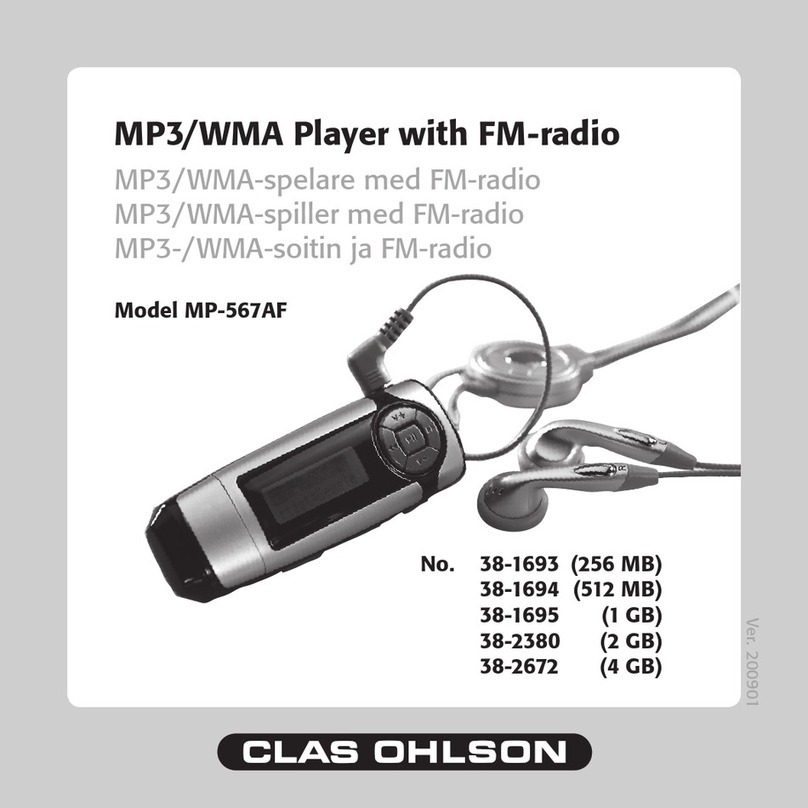
Clas Ohlson
Clas Ohlson MP-567AF User manual
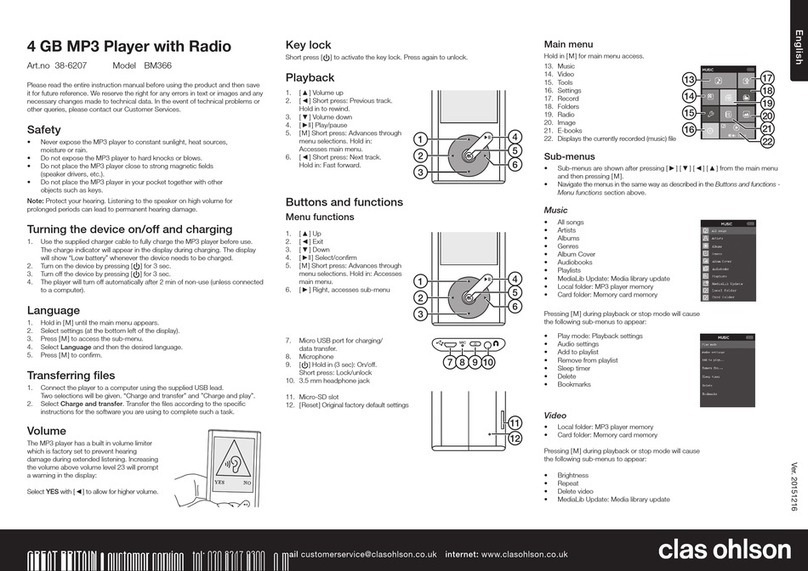
Clas Ohlson
Clas Ohlson BM366 User manual
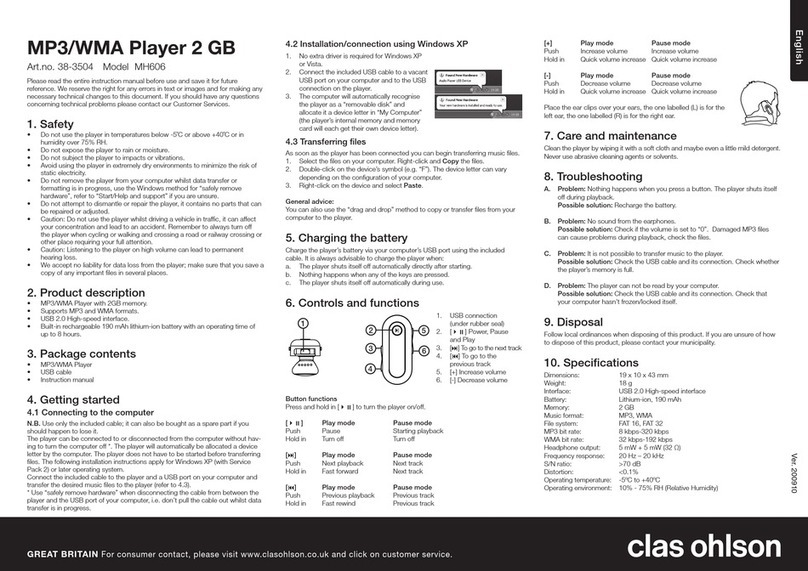
Clas Ohlson
Clas Ohlson MH606 User manual
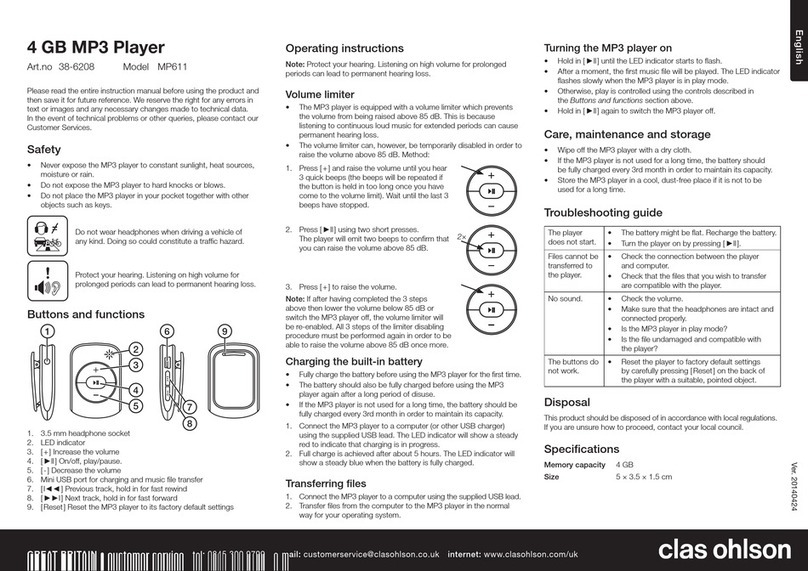
Clas Ohlson
Clas Ohlson MP611 User manual

Clas Ohlson
Clas Ohlson PT15 User manual
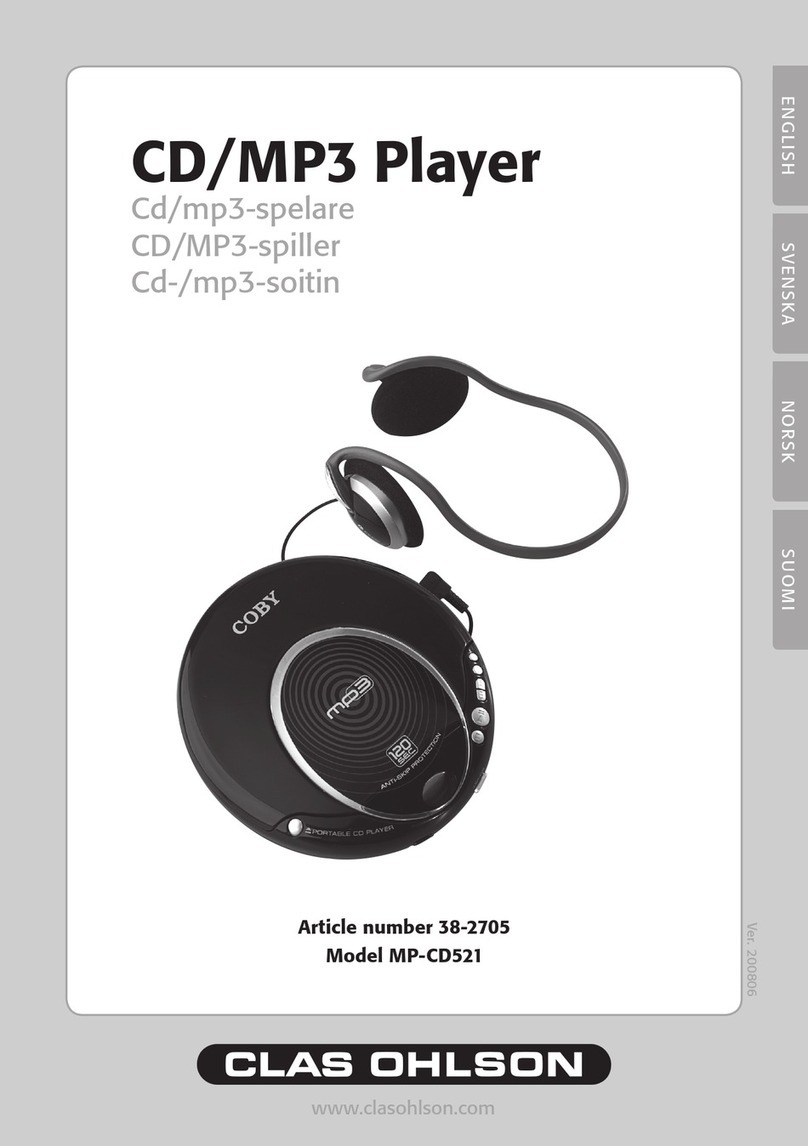
Clas Ohlson
Clas Ohlson COBY MP-CD521 User manual
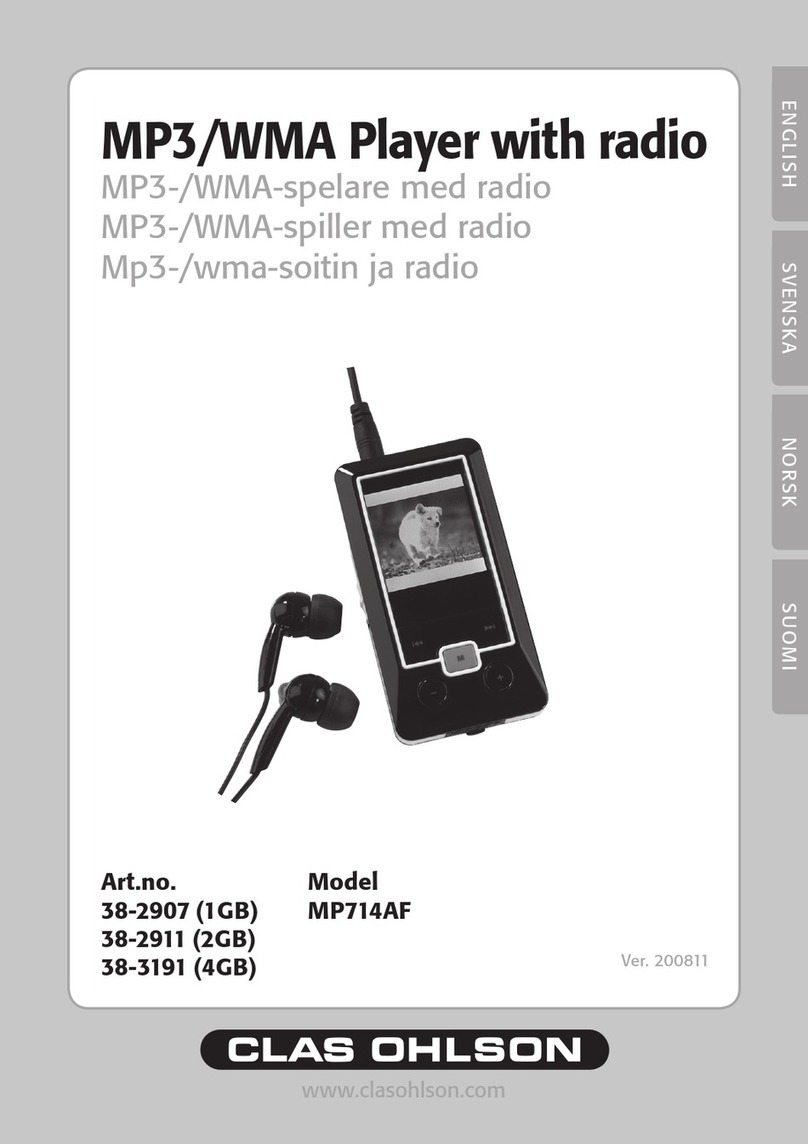
Clas Ohlson
Clas Ohlson MP714AF User manual
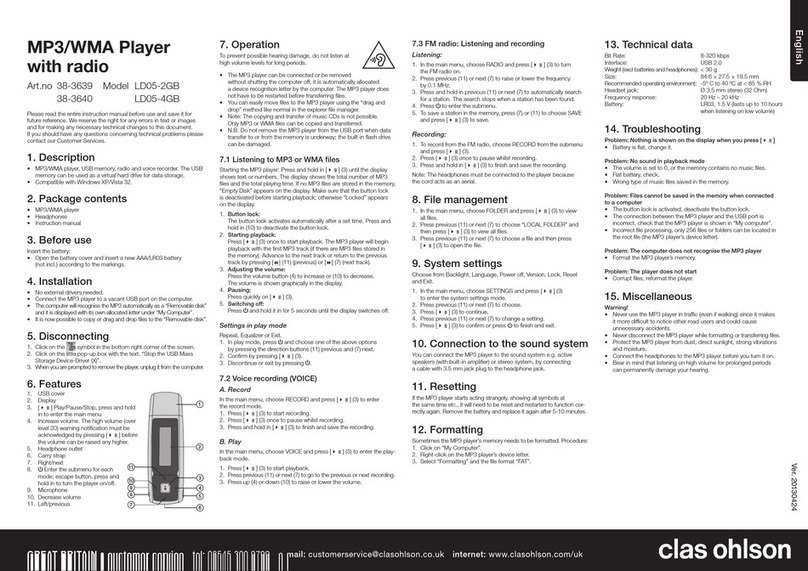
Clas Ohlson
Clas Ohlson LD05-2GB User manual
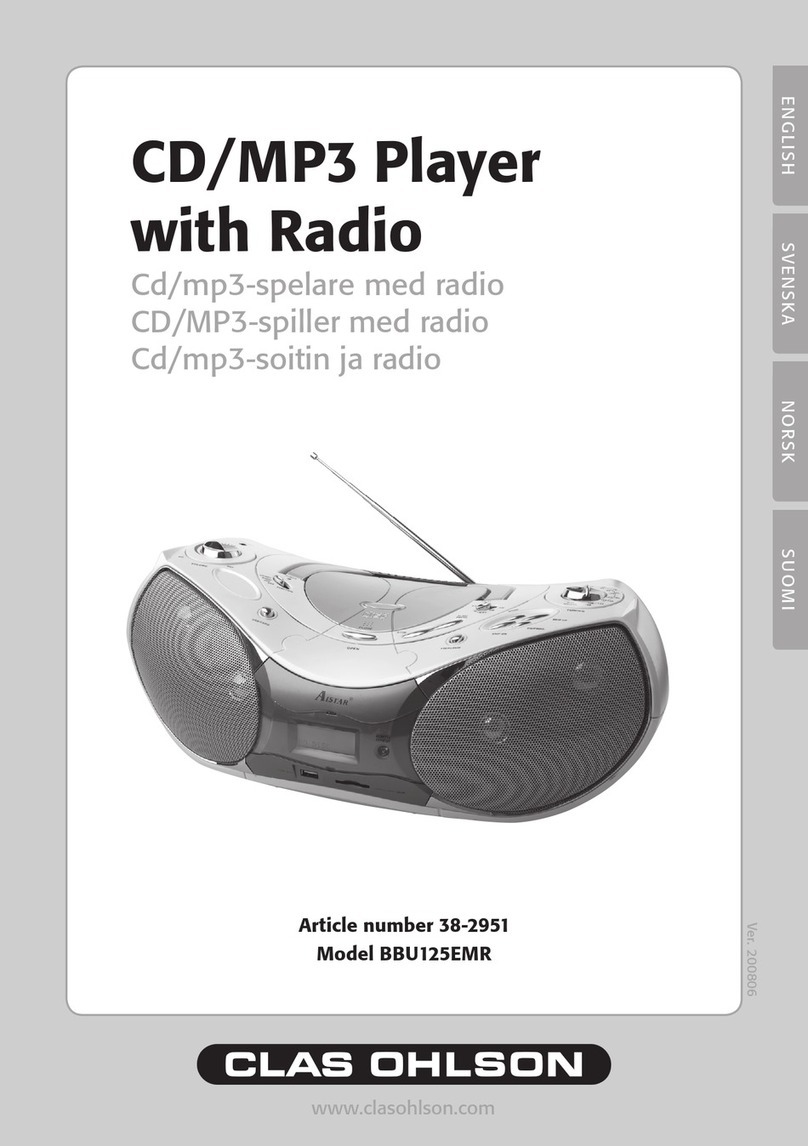
Clas Ohlson
Clas Ohlson BBU125EMR User manual
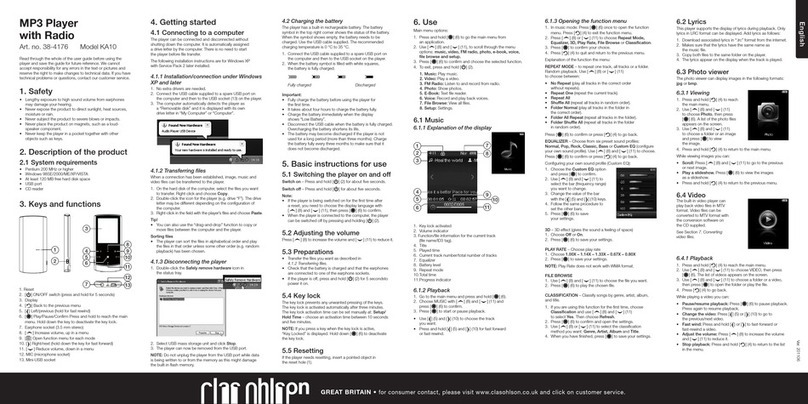
Clas Ohlson
Clas Ohlson KA10 User manual
